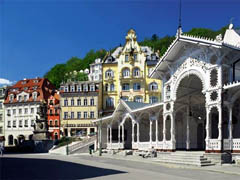
K. Vary have agreed with the region to rescue the peat pavilion
 |
The city and regional leadership had previously entered into a dispute when the mayor's deputy Jiří Klsák (KOA) came forward with a request to preserve the pavilion during reconstruction, as it also has historical value.
"We agreed to prepare a schedule for modifications to the project so that the pavilion remains preserved. The city will cooperate on this and will try to shorten all the deadlines required for the project changes as much as possible," said Novotný.
However, the region and the city must complete everything in the shortest time possible, as in the autumn, the region intends to apply for a grant from the Integrated Operational Program of the Ministry of Culture and the building permit for the modified project must be completed by February.
However, saving the pavilion will require higher costs. According to Novotný, around 40 million crowns. "Deputy Klsák promised that he would try to advocate for an increase in the city's contribution," Novotný stated.
According to Klsák, it is good that the city has reached an agreement with the region. "The peat pavilion is part of the monument; it is somewhat its heart, where peat was once prepared so that the Imperial Baths could function at all," Klsák stated. He told ČTK today that negotiations would continue. "The city will contribute 100 million to the reconstruction, which the previous council has already promised. We will only talk about a possible further increase that the modifications to the project will require," Klsák stated.
"I firmly believe that we have overcome the disagreements that arose apparently due to misunderstandings, and we are on the right path to further cooperation, so that the monument itself will benefit from it," added Klsák.
However, how the pavilion could be used after reconstruction is also not clear yet. With the change of the project, it will be necessary to find a suitable use for it. Klsák noted that it could house an information center, an exhibition on spa treatments, and similar facilities. "We still need to agree on that, but we also need to agree quickly so that the designers can start working on it," Klsák added.
The total costs for the reconstruction of the Imperial Baths, built at the end of the 19th century, are expected to reach around 800 to 900 million crowns. The financing of the project will come from the Integrated Operational Program National Support for the Use of Cultural Heritage Potential and from the Regional Operational Program. The region and the city will also contribute from their budgets.
The English translation is powered by AI tool. Switch to Czech to view the original text source.











